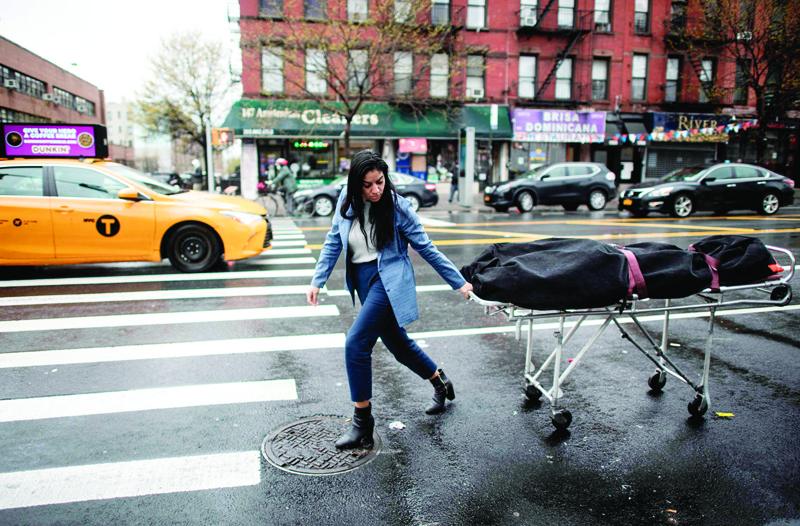
NEW YORK: At a New York funeral home, the undertakers can't bear to disappoint grieving families so they try to accept all coronavirus victims even if it means they are overwhelmed. The number of daily COVID-19 deaths has halved from the peak 799 that New York recorded on April 9, but the phone at International Funeral & Cremation Services, a female-run business in Harlem, is still ringing off the hook. "They're desperate, they're like, 'Hey, they're going to send my loved one to Potter's Field, the hospitals can't hold their body anymore. Can you help? Can you help?'" said funeral director Nicole Warring, one of four women who run the parlor.
"And it is so hard to say, give me a call back in two days, so that just breaks my heart," she told AFP. They have been inundated with COVID-19 victims since New York became the epicenter of America's outbreak last month. For many families in the state, where more than 20,000 people are thought to have died from the virus, finding a funeral home able to accept their relative is a challenge.
"We had people from all over the boroughs calling because a lot of funeral homes are filled to capacity. They're not even taking any more calls," said Warring. Manager Alisha Narvaez also hates adding to the pain of the recently bereaved so endeavors to accept every body, meaning the staff are working day and night. "It's frustrating for me to not be able to service them the way I'd like. So the hardest part is turning families down, which I try not to do," said Narvaez.
'It's tough'
One day last week AFP watched the undertakers bring two bodies to the funeral home in the back of a nondescript minivan. Often they have driven to one of several white refrigerated trucks strewn across the city in recent weeks to collect the dead. "Some of the trailers, the bodies (are) on the floors," said Warring. "I don't want to step on anyone-it's just an overflow of bodies and it's traumatizing."
Narvaez, wearing heels, and staff member Lily Sage Weinrieb transported the bodies, which were in bags marked "COVID-19," into the premises on a stretcher. Inside, the team prepares the bodies, completes administrative procedures and performs ceremonies in a special room where only ten people are permitted because of social distancing restrictions. The bodies are then cremated at another site. When it's a COVID-19 case relatives rarely attend.
"People are in quarantine and don't come for services. So it'll just be us-the director with the loved one at the cemetery. And so we'll record it and send it to (friends and family). It's tough," said Narvaez. Narvaez, in her 30s, has been working seven days a week throughout the crisis but doesn't envisage being able to get some rest anytime soon. "We have a backlog. So for us it will be a bit chaotic still for another two months maybe. "I just hope it does slow down a little bit because I really need a break. I need a vacation after this," she said.
New York's homeless
Meanwhile, New York leaders pledged to take action against a surge of homeless people sleeping on empty subway trains during the city's coronavirus crisis. Photos and video showing the homeless seeking shelter in the Big Apple's underground transit system have circulated widely on social media this week, sparking outrage. "The cars were filthy, they were disgusting, homeless people were there with all their belongings," said Governor Andrew Cuomo, lamenting a "deterioration" in the conditions of the network.
He ordered the Metropolitan Transportation Authority, the independent body which runs the subway, to come up with a plan to scrub every train every day. "Any essential worker who shows up and gets on a train should know that that train was disinfected the night before. "The trains have to be clean," Cuomo told reporters, adding that the homeless should also be able to get the services that they need.
New York's lockdown, implemented in mid-March, has resulted in a 90 percent drop in riders, freeing up space on trains and in stations for people who sleep on the streets. The New York Post tabloid on Tuesday published a video shot by a conductor which showed multiple people sleeping on benches in various cars of a single train. Piles of boxes, bags and luggage lay beside them.
"I gotta go to work in this. It's not making any sense," the conductor, 25-year-old Torry Chalmers, can be heard saying. It followed photos published by rival tabloid the Daily News which showed similar scenes. The MTA has been the subject of a tussle between the mayor and the governor for years with both passing the buck for who is responsible for investing in the much-maligned metro. In a column published in the New York Post Monday, the MTA's acting president called on Mayor Bill de Blasio not to let the underground become a shelter for the homeless.
De Blasio announced a proposal this week to close ten end-of-line stations between midnight and 5:00 am to allow carriages to be cleaned and police to empty stations of any homeless people. It would also allow outreach workers to help move the homeless into shelters. However overcrowding in the city's shelters has led to fears that COVID-19 could spread there. Social media users sympathetic to the plight of the homeless say they are forced to go underground because of a lack of other options, with cafes closed due to the lockdown.- Agencies










